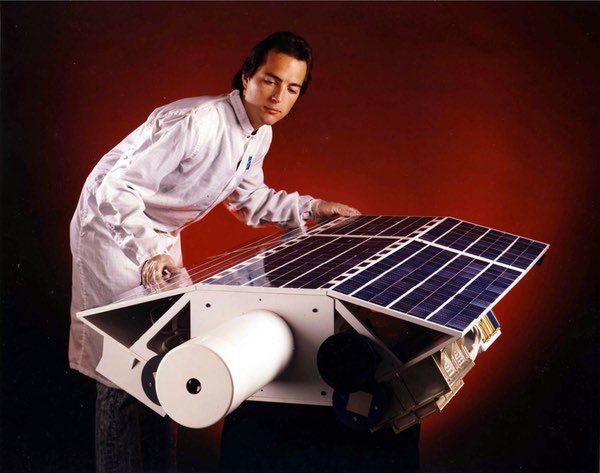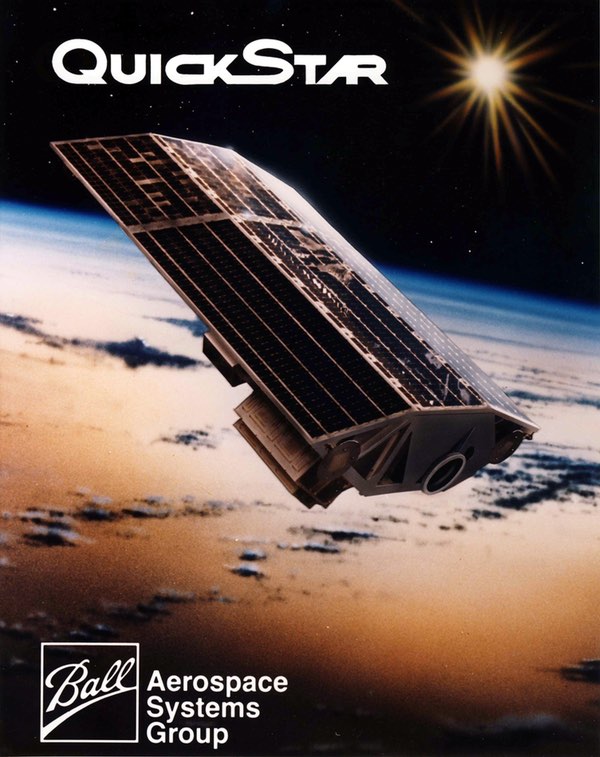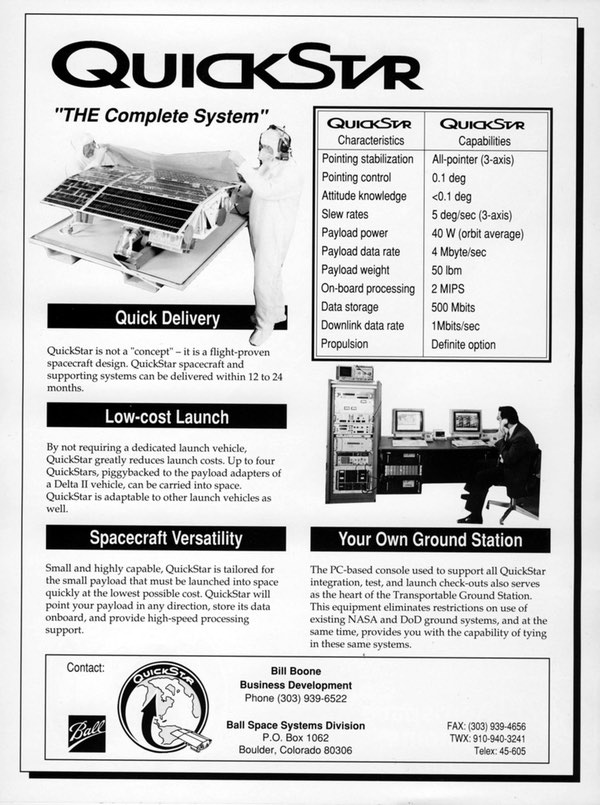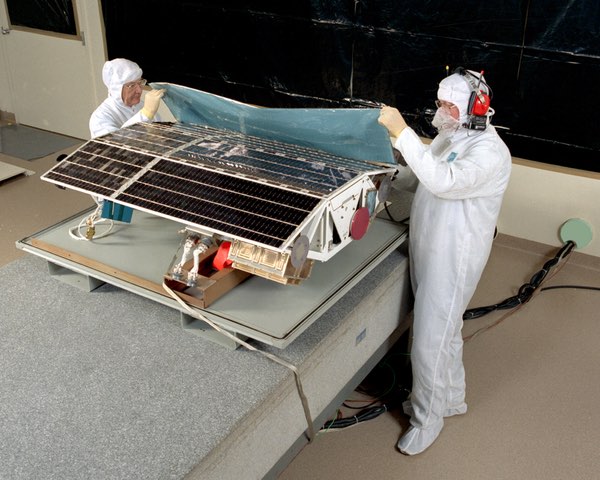Objects in space: LOSAT-X and QuickStarby Dwayne A. Day
|
| LOSAT-X was not only an SDI satellite. Its manufacturers at Ball Aerospace Systems Group intended it to be the prototype for the company’s new QuickStar line of low-cost satellites. |
Initially many SDI concepts were for large spacecraft equipped with lasers and particle beam weapons capable of destroying many Soviet ICBMs at a time. But by the latter 1980s, SDI planning had evolved in favor of a concept known as “Brilliant Pebbles,” which would involve orbiting many thousands of small satellites that could then individually intercept warheads as they sailed through space. The satellites would have to do their own final tracking and interception, slamming into the warheads at speeds of many kilometers per second.
LOSAT-X, or “LOw altitude SATellite eXperimental,” was lofted into orbit in July 1991 as a secondary payload aboard a Delta II rocket carrying the GPS-2A 2 satellite as a test for Brilliant Pebbles. LOSAT-X’s mission was to observe rocket burns using some small prototype sensors. Recently, Charlie Hoffman, a former lead engineer for LOSAT-X, reminisced about the mission and provided some new details about how and why it was built, and how it ended.
 Technician and spacecraft. (credit: Ball Aerospace & Technologies Corp.) |
Quicker, cheaper, better?
LOSAT-X was not only an SDI satellite. Its manufacturers at Ball Aerospace Systems Group intended it to be the prototype for the company’s new QuickStar line of low-cost satellites. Ball had started a project in 1988 called TechStars to examine small satellite systems and incorporate new technologies into a new and capable low Earth orbit satellite, eventually designated QuickStar. Ball’s engineers hoped that QuickStar would soon attract a number of scientific customers at NASA, lured in by its price and flexibility. In addition to its relative inexpensiveness, QuickStar also used a low-cost, multi-purpose ground station.
QuickStar was a three-axis stabilized satellite. “The reaction wheels were designed and built by Ball specifically for QuickStar satellites,” Hoffman explained. “They were considerably less expensive than buying wheels, since none of the vendors, Ithaco or Honeywell at the time, had one small enough.”
One side of the spacecraft was covered with solar panels. “The solar panel was curved,” said Hoffman. “It actually was three separate panels mounted at oblique angles to one another so that they approximated the internal curvature of the fairing.” This design was reminiscent of Lockheed’s P-11 series electronic intelligence satellites first launched in the early 1960s, and Boeing’s “Secondary Science Satellite,” or S3, satellites launched in the 1970s. CHIPsat, which was launched on a Delta II in 2003, had a similar shape for the same reason. But compared to those other satellites, QuickStar was more slender and elegant. Up to four QuickStars could be launched on a Delta II depending upon the mission.
The design lifetime for LOSAT-X was six months, with a one-year goal. The satellite was equipped with three reaction wheels, three magnetic torque rods, a wide field-of-view star camera, and a three-axis gyro package to provide three-axis stabilization. Ball’s goal was to provide greater capability than other small satellites, such as pointing control to 0.1 degree (compared to a more common one to three degrees), 214 watts of power, and five times the onboard data storage capacity using solid-state memory.
The spacecraft structure was approximately 1.2 meters long, 0.9 meters wide, 0.3 meters deep, and weighed 75 kilograms. The three solar panels provided approximately 1.11 square meters of solar array area. Thermal control was passive, accomplished by low absorption/high reflection finishes.
During normal operations, QuickStar pointed its solar panels to the sun line using the star camera for determining the satellite’s attitude. But the satellite could be placed in different pointing modes that would allow it to track a specific location. Because the star tracker could not be used during this time, the gyro would provide reference. Hoffman noted that the satellite had another mode too. “LOSAT also had two sun sensors, for two-axis sun pointing without using the more complicated star camera algorithms,” he explained. “Sun sensors can be hardwired into the control system, and that was a common approach for redundancy and mission safety.”
| “The original schedule to launch with LOSAT-L and R was tremendously ambitious, something like six months from start to launch,” Hoffman remembered. |
QuickStar’s payload volume was at the center lengthwise axis of the spacecraft and was approximately 0.048 cubic meters. The payload could look down at the Earth, up through holes in the solar panels to image the sun, or out through the front to perform astronomy. The satellite could carry instruments that extended beyond the payload cavity provided that there was room inside the payload shroud and depending upon the type of primary payload that was being carried. Scientific payloads could be an ultraviolet spectrometer, an electron detector and Earth sensor, proton/electron, solar cosmic ray and galactic X-ray sensors, or an X-ray spectrometer and electronics.
For some missions the satellite could carry a small hydrazine thruster with sufficient propellant to change the velocity by 76 to 91 meters per second. That thruster was apparently not carried on the LOSAT-X mission, however.
QuickStar was designed from the ground up to be an inexpensive spacecraft and that goal extended to the ground station as well. The satellite ground station was designed to be small and relatively easy to install at a government or even university facility and used commercial grade computer systems.
 Ball envisioned a range of potential applications for its QuickStar smallsat system. (credit: Ball Aerospace & Technologies Corp.) |
Launching LOSAT-X
Many of the Strategic Defense Initiative Organization’s (SDIO) earlier larger satellite launches had involved sensor tests to establish what rockets and small warheads looked like from space. Some had also been proof-of-concept vehicles to demonstrate that it was possible to intercept a warhead. By 1991, SDI’s engineers were zeroing in on designs for an operational weapon, although by this time the Cold War was essentially over. LOSAT-X was in some ways one of the last acts of a play that was about to end.
LOSAT-X was originally supposed to fly with LOSAT-L and LOSAT-R in early 1990, which, despite their names, were entirely different designs. But LOSAT-X was not ready until the following year and did not fly with its adopted siblings. “The original schedule to launch with LOSAT-L and R was tremendously ambitious, something like six months from start to launch,” Hoffman remembered. “Ball Aerospace & Technologies Corp. did get LOSAT-X fabricated in time, but the software was not ready,” he added. “Incidentally, LOSAT-R was the highly acclaimed Relay Mirror Experiment, also built and operated by Ball Aerospace & Technologies Corp.”
According to Wayne Eleazer, who worked on launch vehicle procurement issues at the Pentagon during this time, one of the reasons that LOSAT-X was shifted to a later launch was because SDIO was locked into a specific launch window with their contract for the Delta II carrying the other two LOSATs and could not delay that launch until LOSAT-X was ready to fly. SDIO officials did try to get LOSAT-X onto the first launch of a Delta II 7925 launch vehicle carrying a GPS satellite scheduled for a November 1990 launch. But the Air Force insisted on carrying extra instrumentation underneath the GPS satellite to determine if the newer more powerful Delta would pose any additional risks to its payloads. As a result, with those two Delta II vehicles unavailable, LOSAT-X had to find another ride, much later than SDIO officials had initially hoped.
A McDonnell Douglas Delta II 7925 rocket lifted off from Cape Canaveral on July 3, 1991, carrying GPS-2A 2. There’s an old saying in the launch business that the primary payload sets the rules and this launch was no different. LOSAT-X was launched powered down so that it could not interfere with the GPS satellite. Only after the Delta’s second stage reached orbit and LOSAT-X was pushed off with springs did the satellite come to life.
Immediately after separation, LOSAT-X powered up its subsystems and payload, stabilized itself, and maneuvered to the required attitude. Approximately 34 minutes later it “performed a crucial element of the mission,” according to a 1992 paper written by Thomas Garrison, the LOSAT-X/QuickStar chief engineer.
According to a contemporary article quoting an unnamed SDIO spokesperson, the satellite carried two sensor packages that “could help determine the design of sensors aboard the Brilliant Pebbles orbiting strategic defense interceptors.” Another source indicated that the payload was a “multispectral sensor for gathering data on ground-launched rocket plumes and the space environment.”
The Delta II’s second stage performed a depletion burn of its engine 36 minutes after LOSAT-X separated and the satellite’s sensors undoubtedly observed the engine burn. This was apparently the primary goal of the mission and therefore it was successful. Unfortunately, the satellite soon had problems.
| Ball Aerospace did not find any more customers for the low-cost satellite. By the early 1990s small satellites were going out of fashion. |
“There were two on-board failures, and I don't know which occurred first,” Hoffman remembered. “One of the three reaction wheels failed. We believe it was due to an improperly installed Hall effect sensor; a lead was likely cracked during installation during the motor winding and further cracked due to launch and thermal cycling on orbit.” That was not the only problem. “There was also a failure of the transceiver,” said Hoffman. “I have no further insight into that.”
The end result of these two malfunctions was that LOSAT-X ceased operating only nine days after launch. This prevented it from accomplishing its secondary objectives, which most likely involved observing missile launches in flight and further validating the sensors. Because of its very low orbit, the satellite decayed and fell back to Earth on November 15, 1991.
Ball’s engineers were hoping that the company could use the satellite to expand their experience base, but the tight schedule made that difficult. “We had very little experience with flight software, and an inadequate test bench, so the software started late and didn’t have the rigor used by today's developers,” Hoffman said. But it was hardware, not software, that prematurely ended the mission.
 A QuickStar ad. (credit: Ball Aerospace & Technologies Corp.) |
QuickStar No More
QuickStar was designed to fly either as a secondary payload on Delta II launches, or could also fly by itself lofted by smaller rockets such as the air-launched Pegasus. But Ball Aerospace did not find any more customers for the low-cost satellite. By the early 1990s small satellites were going out of fashion. They had enjoyed a brief renaissance in the late 1980s and early 1990s, particularly after the Defense Advanced Research Projects Agency (DARPA) sponsored a number of projects. But this support evaporated.
“In addition to small satellites losing favor, secondary payloads never really gained favor,” Hoffman explained. “Also the secondary is limited to flying pretty much the same orbit as the primary,” he added. That remains a major obstacle currently facing many CubeSat projects.
SDIO was also undergoing a transformation. With the Cold War essentially over, a missile shield no longer seemed so important. When Bill Clinton became President in January 1993, he also cut back on missile defense and redirected it from strategic to theater defense, primarily ground-based. SDIO was renamed the Ballistic Missile Defense Organization, Brilliant Pebbles was soon forgotten, and thus a potential QuickStar customer disappeared.
Within a few years, NASA began adopting the “faster, better, cheaper” design philosophy pioneered by SDIO and epitomized by satellites like LOSAT-X and QuickStar. But QuickStar did not benefit from this resurgence. “Although the community was enamored with the idea of smallsats in general and QuickStar in particular,” Hoffman said, “the payloads generally required more size, weight, and power than QuickStar could provide.” When NASA eventually began flying smaller spacecraft, they were not as small as the slender little QuickStar.
In many ways, LOSAT-X appeared at the twilight of two eras in American spaceflight: the end of the SDIO space program, and the fading of the Pentagon’s brief enthusiasm for small satellites. But QuickStar was also a sort of predecessor to today’s CubeSats, taking small payloads to orbit by hitching a ride from another satellite.
Acknowledgement: The author would like to thank Charlie Hoffman and the people at Ball Aerospace & Technologies Corp. for their help.
